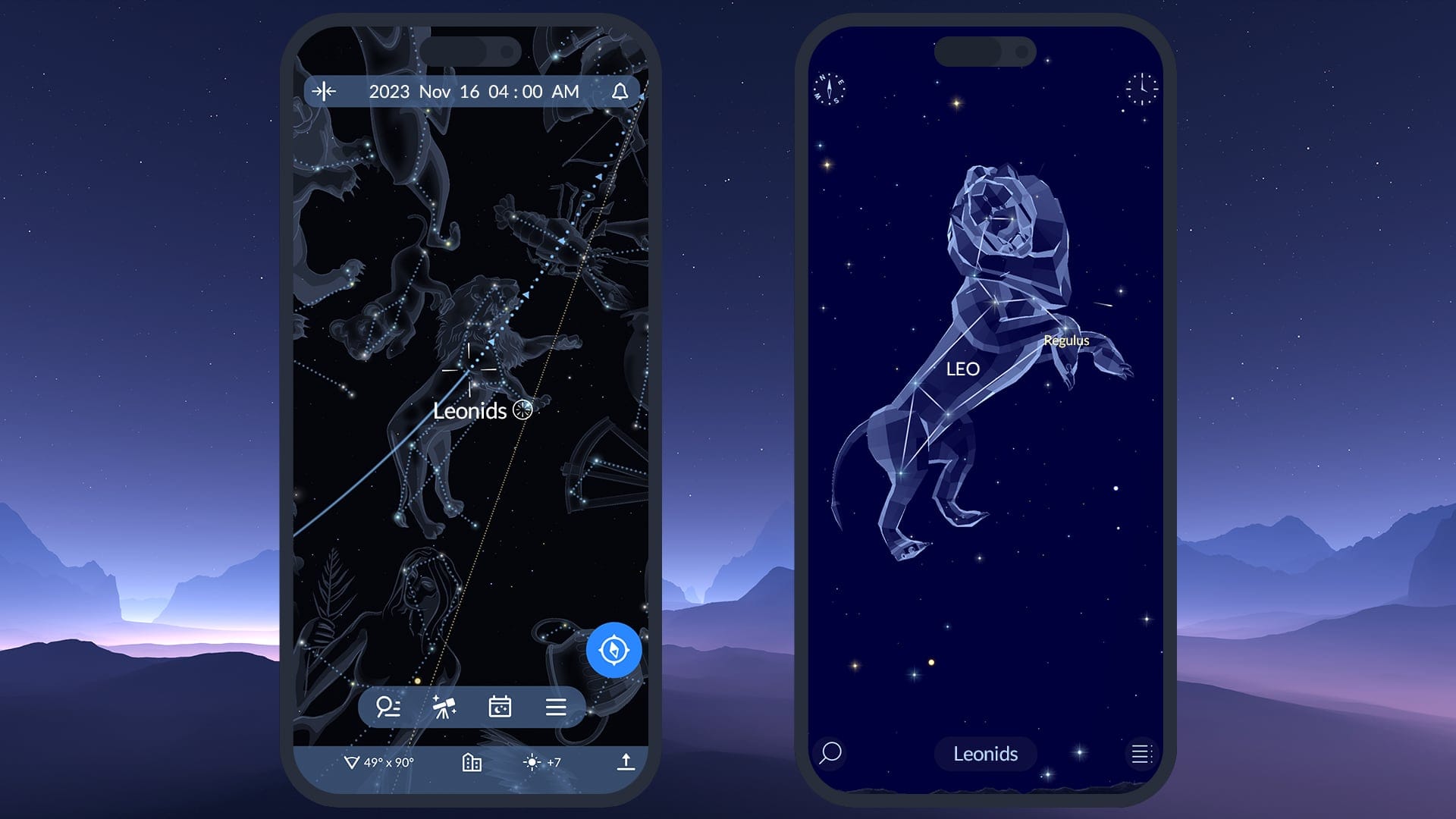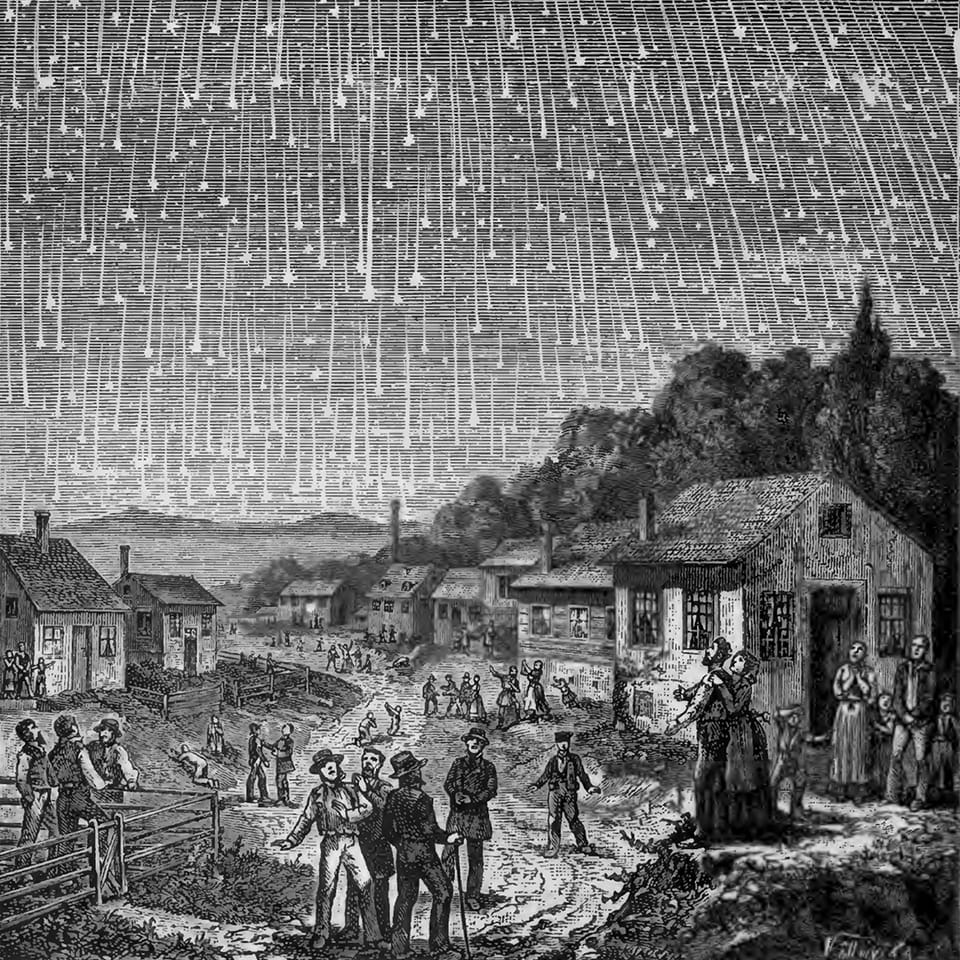Leonid Meteor Shower in November 2025: When & How to See?
The Leonids will peak on November 16–17, 2025, producing up to 15 meteors per hour under dark skies. Known for their rare outbursts roughly every 33 years, the Leonids are among the most spectacular meteor showers to watch. Use Sky Tonight to find the best viewing time — and read on to learn more about observing the Leonids this year.
Contents
- How to observe the Leonid meteor shower in November 2025?
- What is the Leonid meteor shower?
- The history of the Leonid meteor shower
- The Leonids 2025: Conclusion
How to observe the Leonid meteor shower in November 2025?
In 2025, the Leonids are estimated to produce up to 15 meteors per hour during their peak on November 16–17. This year's viewing conditions are favorable as the meteor shower's peak occurs several days before the New Moon.
When can you see the Leonid meteor shower?
The Leonid meteor shower is active from November 6 to 30, with a peak on November 16–17. In 2025, the meteor shower is expected to reach its maximum around 18:00 GMT (1:00 p.m. EST) on November 17 (with possible minor peaks of activity later that evening). If the radiant point (in the constellation Leo) is already above the horizon in your city at that time, your chances of spotting meteors will be much higher. You may also want to try observing the Leonids on the morning of November 18.
Where to look for the Leonids?
The meteor shower’s radiant is located in the constellation Leo – this is the point from where the Leonids appear to originate. However, you don't have to look specifically at this constellation. It's better to keep in view as much of the night sky as possible. The meteors flying farther from the radiant will have longer tails, which are easier to spot and look better in photos. Still, if you want to have a reference point, here is how to find the location of the Leonids radiant using the Star Walk 2 or Sky Tonight apps:
- Open one of the apps and type “Leonids” in search.
- In Sky Tonight, tap the target button next to the Leonids’ meteor shower radiant; in Star Walk 2, just tap the result. You’ll see the location of the meteor shower’s radiant on the sky map on a given date.
- Point your device at the sky, so that the image on the screen adjusts to the real sky above you. Now follow the arrow to find out the location of the Leonids’ radiant above you right now.

What is the Leonid meteor shower?
The Leonid meteor shower is an annual meteor shower that peaks in mid-November. It belongs to the major meteor showers, which are easy to observe even for inexperienced meteor hunters. The parent body of the Leonids is the comet Tempel-Tuttle. Their radiant point is located in the constellation Leo — the meteors appear to originate from this constellation.
Unlike the Taurids, which are also visible in November, the Leonid meteors are very fast. More than 200 times faster than a rifle bullet, a glowing Leonid meteor flies at a speed of 71 kilometers per second and leaves behind a long blue-green trail. Its vapor trains may linger in the sky like enormous smoke rings for five minutes or more.
The history of the Leonid meteor shower
The Leonid stream is indeed one of the greatest meteor showers ever seen. Although its common display is not that outstanding, there were times when the Leonids appeared like a true rain of meteors, astonishing regular observers and inspiring scientific research.
Leonid meteor shower in 1833: the first meteor storm
In November 1833, the Leonids produced the first great storm of modern times — the rate of meteors was 100,000 per hour! That storm had a significant effect on the development of the scientific study of meteors.
Previously, astronomers thought that meteors were atmospheric phenomena, like rain or snow. But the activity of the Leonids in November 1833 made them curious, so different theories began to emerge. In January 1834, Denison Olmsted suggested that the meteors had originated from a cloud of particles in space. In 1865, astronomers discovered a comet to which they associated the Leonids. The comet was afterward named Tempel-Tuttle. The orbital period of the comet was estimated at about 33 years, so some astronomers predicted that there would be another massive activity of the Leonid meteor shower in 1866 — this turned out to be true.

The Leonids in 1966: 15 minutes of the meteor storm
In 1966, there was another remarkable outburst of the Leonid meteor shower. On November 17, fortunate observers in North America and Hawaii witnessed 40 to 50 meteors streaking across the sky every second. This breathtaking display continued for 15 minutes, leaving the observers in awe. The following morning, November 18, the celestial spectacle extended its grace to East Asian countries and Australia, where it showered down thousands more meteors.
Continuing history of the Leonid meteor storm
The Leonid storm’s recorded appearance is relatively stable — almost every 33 years, this meteor shower produces an amazing view in the sky. However, until the end of the 20th century, astronomers still didn’t know how to forecast meteor shower activity accurately. Only by the end of the 1990s, when computers became powerful enough, the researchers managed to calculate the Leonid activity for several years. The 1999 Leonid storm was the first to be confidently predicted using this method. Nowadays, we have predictions about the outburst in the Leonids’ activity down to ten minutes. According to these predictions, the next time we may see up to 400 Leonid meteors per hour is on November 17, 2033.
The Leonids 2025: Conclusion
In 2025, the Leonid meteor shower will offer a beautiful celestial show, with up to 15 meteors per hour visible at its peak on November 16–17. The viewing conditions will be excellent thanks to the dark sky before the New Moon. Find a spot away from city lights, give your eyes time to adjust, and enjoy the sight of fast, colorful meteors streaking across the night sky. You can also use the Sky Tonight app to check the peak time for your exact location.
Good luck with your meteor hunting!
